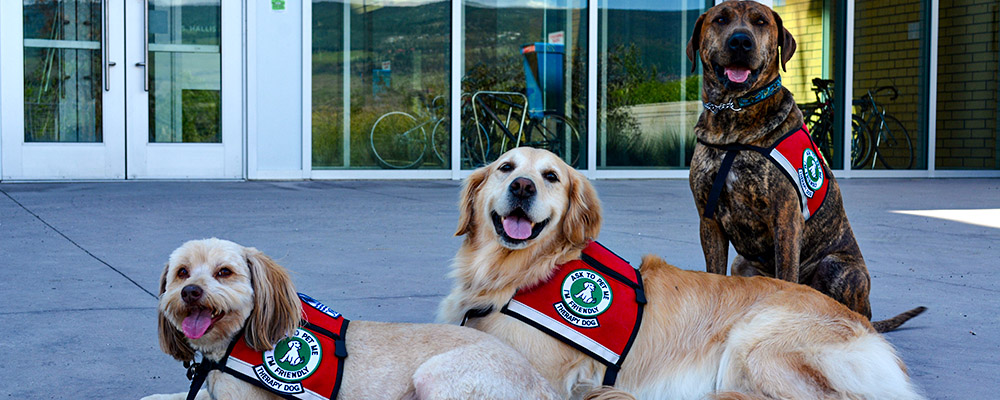New Dog Intake Assessment

Holistic Assessment of Therapy Dogs
In lieu of using a checklist and rating scales to determine the suitability of a dog for our programs, B.A.R.K. employs holistic assessment. Holistic assessment allows B.A.R.K. examiners to determine an overall “impression of suitability” or match for what B.A.R.K. asks of dogs. Unlike many animal-assisted therapy (AAT) programs where one dog is brought into a facility to interact with clients, B.A.R.K. does things differently.
In contrast to the traditional AAT model, B.A.R.K. sessions see multiple clients, multiple handlers, and multiple dogs (as many as 15+) in one room. Recognizing that dogs are “social catalysts” who help foster interpersonal connections (lacking for many students), a group approach has proven effective in reducing stress in students, increasing perceptions of adult- and peer- support, and increasing students’ affinity for UBC.
Intake Process
In order to have you and your dog become credentialed and accepted into UBC’s B.A.R.K. program, all volunteers must complete the full intake process.
- Initial application form
Prospective handlers are asked to complete a brief questionnaire to provide more information on themselves, and their dog. This includes questions about canine behaviour, health, and wellbeing, volunteer availability, and previous volunteer experience. More information, including the application form, can be found on our Volunteer Handler page. This application places prospective handlers on a waitlist.
- Successful applicants will then be invited to attend four in-person sessions. Attendance at these sessions is required.
- Handler orientation
- Assessment training workshop
- Assessment of prospective handler-dog teams
- Mock session
- Upon successful completion of these stages, handlers must attend abbreviated drop-in sessions during an internship period of four to eight months.
Dog Assessment Criteria
Throughout the multi-step assessment process, canine-handler teams are evaluated based on their demonstration of set skills. These include:
- Basic obedience (e.g. “Sit”, “Down”, “Stay”, “Leave it” and “Come”)
- Dog’s reaction to:
- Distractions and sudden noises
- Neutral dog
- Children
- Dog’s ability to:
- Accept a friendly stranger / acceptance of varied, diverse individuals
- Accept a treat
- Walk on a loose leash
- Walk in a crowd
- Ability for the handler to manage scenarios including:
- Awareness and management of your dog
- Teaching others how to greet a dog
- Managing several people who want to pet dog
- Setting limits upon clients using restraining hugs
- Setting limits upon clients’ requests to take control of the dog
- Handling
- Grooming/Appearance
Dog Assessment Rating
To increase the accuracy of our assessment practices, B.A.R.K. uses four raters who holistically assess dogs on each of our identified assessment criteria. Our raters have extensive experience with dogs, having worked as trainers or assessors in other contexts. Three outcomes arise from B.A.R.K.’s assessment of new dogs:
- Acceptance into programming
- “Not quite ready” for programming
- Unsuitable for programming
Canine-Assisted Interventions: A Comprehensive Guide to Credentialing Therapy Dog Teams
by John-Tyler Binfet and Elizabeth Kjellstrand Hartwig
Covering principles of therapy dog team training, assessment, skills, and ongoing monitoring, Canine-Assisted Interventions provides guidance on the most evidence-based methods for therapy dog team welfare, training, and assessment.
